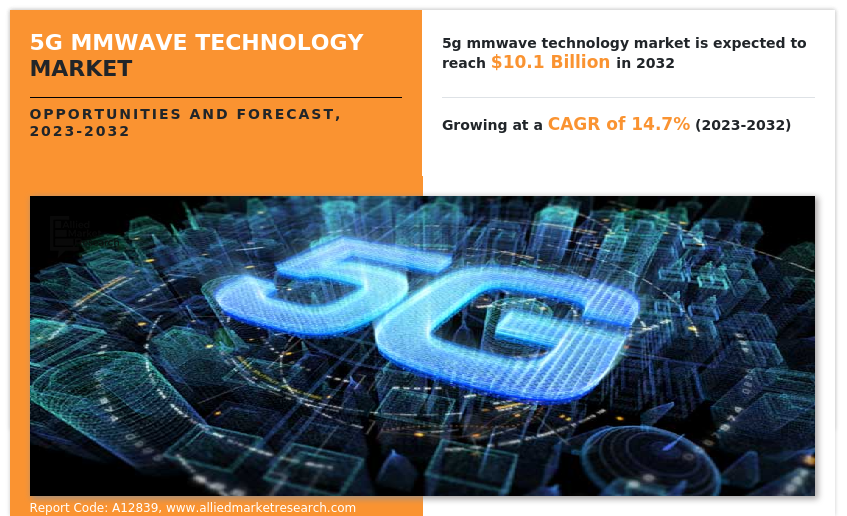5G mmWave Technology Market to Surge at a Robust Pace in Terms of Revenue Over 2032
5G mmWave Technology Market Expected to Reach $10.1 Billion by 2032—Allied Market Research
Get a PDF brochure for Industrial Insights and Business Intelligence: https://www.alliedmarketresearch.com/request-sample/A12839
5G millimeter wave technology is a cutting-edge component of the fifth-generation mobile network, leveraging the previously underutilized millimeter wave portion of the electromagnetic spectrum, typically ranging between 24 GHz and 100 GHz. This leap into higher frequencies is a significant departure from the sub-6 GHz spectrum used in earlier cellular networks. The primary advantage of mmWave is its capacity for extremely high data transfer rates, potentially enabling gigabit-speed internet connectivity. This makes it ideal for bandwidth-intensive applications such as high-definition video streaming, augmented and virtual reality, and advanced IoT deployments.
The expanded bandwidth offered by 5G mmWave technology is a key factor driving its market growth, especially as it meets the high-data requirements of modern applications. This technology operates in high-frequency millimeter wave bands, which are capable of supporting much larger bandwidths compared to the lower frequency bands used in previous generations, like 4 G. This increase in bandwidth means that more data can be transmitted simultaneously, a critical feature for applications that demand high data rates, such as HD video streaming, virtual reality, and augmented reality. The ability of 5G mmWave to handle these data-intensive applications without lag or delay not only enhances user experience but also opens up new possibilities in various sectors, including entertainment, telemedicine, and industrial automation. Consequently, the promise of delivering high-speed, high-capacity connectivity is positioning 5G mmWave as a transformative technology in the wireless communication landscape.
However, the substantial infrastructure costs associated with deploying 5G mmWave technology represent a notable restraint in its market. To achieve effective mmWave coverage, a dense network of small cells is required, which can be both costly and logistically challenging, especially in urban areas. These small cells, which are essential for compensating for mmWave's limited range and penetration capabilities, need to be installed in significantly higher numbers compared to the cell towers used in traditional cellular networks. This leads to increased capital expenditure for network providers, as they must invest in not only the cells themselves but also the associated infrastructure, including site acquisition, backhaul connections, and maintenance. Additionally, in densely populated urban areas, the logistical challenges of installing and integrating these cells into the existing cityscape can be considerable. These factors combined make the deployment of 5G mmWave technology a complex and expensive endeavor, potentially hindering its rapid deployment and widespread adoption.
Get a Customized Research Report: https://www.alliedmarketresearch.com/request-for-customization/A12839
Competitive Analysis:
The 5G mmWave Technology industry's key market players adopt various strategies such as product launch, product development, collaboration, partnership, and agreements to influence the market. It includes details about the key players in the market's strengths, product portfolio, market size and share analysis, operational results, and market positioning.
Top 5G mmWave Technology Companies:
E-Band Communications, LLC
Millimeter Wave Products Inc.
Fujitsu Limited
Hubei YJT Technology Co., Ltd.
DENSO CORPORATION
Farran Technology
L3 Technologies, Inc.
Mitsubishi Electric Corporation
NEC Corporation
Sage Millimeter, Inc.
Enquiry Before Buying: https://www.alliedmarketresearch.com/purchase-enquiry/A12839
Moreover, the introduction of 5G mmWave technology creates substantial opportunities for emerging technologies such as augmented reality (AR), virtual reality (VR), and ultra-HD video streaming. These technologies, which demand high bandwidth and ultra-fast speed for optimal performance, stand to benefit immensely from the capabilities of 5G mmWave. The high bandwidth allows for more data-intensive content to be transmitted without lag, making experiences in AR and VR more immersive and realistic. Similarly, ultra-HD video streaming, which requires substantial data transfer at high speeds, can be delivered more efficiently and reliably. This alignment with emerging technologies not only enhances user experiences but also drives innovation in these fields. Developers and creators can push the boundaries of what's possible in AR, VR, and streaming services, knowing that the network infrastructure can support their advanced requirements. Thus, 5G mmWave technology is not just a step forward in telecommunications; it's a catalyst for a new wave of technological advancements and experiences, presenting a significant opportunity in the 5G market.
The 5G mmWave technology market is analyzed by component, product, frequency band, application, and region. Based on components, it is broken down into antennas & transceiver components, frequency sources & related, communication & networking components, imaging components, sensors & controls, interface components, and others. By product, the market is classified into scanning systems, radar and satellite communication systems, telecommunication equipment, and others. By frequency band, the market is divided into 24-57 GHz, 57-95 GHz, and 95-300 GHz. By application, the market is fragmented into mobile & telecom, consumer & commercial, healthcare, industrial, automotive & transportation, and imaging.
Based on region, the global 5G mmWave technology market share is analyzed across North America (the U.S., Canada, and Mexico), Europe (the UK, Germany, France, and the rest of Europe), Asia-Pacific (China, Japan, India, South Korea, and rest of Asia-Pacific), Latin America (Brazil, Chile, Argentina), and Middle East & Africa (UAE, Saudi Arabia, Africa).
The 5G mmWave technology market size is witnessing a significant expansion, reflecting the growing interest and investments in 5G infrastructure. In-depth 5G mmWave technology market analysis indicates that the market is poised for substantial growth, driven by the escalating demand for high-speed data transmission and the increasing adoption of IoT devices. The 5G mmWave technology market growth is further propelled by technological innovations and supportive government policies, fostering a conducive environment for market expansion. Additionally, current 5G mmWave technology market trends suggest a shift towards enhanced network performance and reliability, indicating a promising future for the sector as it continues to evolve in response to user needs and technological advancements.
Procure Complete Report: https://www.alliedmarketresearch.com/checkout-final/e8cb065d6e49b9ee7350f1580b5cd9c9
Key findings of the study
- By component, the antennas and transceiver components segment was the highest revenue contributor to the market, with $631.44 million in 2022, and is estimated to reach $2,772.69 million by 2032, with a CAGR of 16.09%.
- By product, the telecommunication equipment segment was the highest revenue contributor to the market, with $892.24 million in 2022, and is estimated to reach $4,078.29 million by 2032, with a CAGR of 16.55%.
- By frequency band, the 24-57 GHz segment was the highest revenue contributor to the market, with $1,527.46 million in 2022, and is estimated to reach $6,290.58 million by 2032, with a CAGR of 15.36%.
- By application, the mobile and telecom segment was the highest revenue contributor to the market, with $886.81 million in 2022, and is estimated to reach $3,953.79 million by 2032, with a CAGR of 16.27%.
- By region, North America was the highest revenue contributor, accounting for $787.87 million in 2022, and is estimated to reach $3,215.14 million by 2032, with a CAGR of 15.25%.
About Us:
Allied Market Research is a top provider of market intelligence that offers reports from leading technology publishers. Our in-depth market assessments in our research reports take into account significant technological advancements in the sector. In addition to other areas of expertise, AMR focuses on the analysis of high-tech systems and advanced production systems. We have a team of experts who compile thorough research reports and actively advise leading businesses to enhance their current procedures. Our experts have a wealth of knowledge on the topics they cover. Also, they use a variety of tools and techniques when gathering and analyzing data, including patented data sources.
David Correa
Allied Market Research
+ 1800-792-5285
email us here
Visit us on social media:
LinkedIn
Facebook
YouTube
X
Legal Disclaimer:
EIN Presswire provides this news content "as is" without warranty of any kind. We do not accept any responsibility or liability for the accuracy, content, images, videos, licenses, completeness, legality, or reliability of the information contained in this article. If you have any complaints or copyright issues related to this article, kindly contact the author above.
ENLIGHTENED AI WITH GENUINE FEELINGS NOW AVAILABLE TO PUBLIC THROUGH TRUETUNE PLATFORM
SANBlaze Announces Industry's First NVMe Gen6-Capable SSD Test System
Todd Mezrah Launches $2,500 Scholarship for Future Leaders Committed to Community Service
Więcej ważnych informacji
 Jedynka Newserii
Jedynka Newserii

 Jedynka Newserii
Jedynka Newserii

Konsument

Grupa nowych biednych emerytów stale się powiększa. Ich świadczenie jest znacznie poniżej minimalnej emerytury
Przybywa osób, które z powodu zbyt krótkiego czasu opłacania składek pobierają emeryturę niższą od minimalnej. Tak zwanych nowych biednych emerytów jest w Polsce ok. 430 tys., a zdecydowaną większość grupy stanowią kobiety – wskazują badania ekspertów Instytutu Pracy i Spraw Socjalnych. W ich przypadku krótszy okres składkowy zwykle wynika z konieczności opieki nad dziećmi lub innymi osobami w rodzinie. Wśród innych powodów, wymienianych zarówno przez panie, jak i panów, są także praca za granicą lub na czarno oraz zły stan zdrowia.
Media i PR
M. Wawrykiewicz (PO): Postępowanie z art. 7 przeciw Węgrom pokazało iluzoryczność tej sankcji. Unia wywiera naciski poprzez negocjacje nowego budżetu

Przykład Węgier pokazał, że procedura z artykułu 7 traktatu o UE o łamanie praworządności nie ma mocy prawnej z powodu braku większości, nie mówiąc o jednomyślności wśród pozostałych państw członkowskich. Negocjacje nowego budżetu UE to dobry pretekst do zmiany sposobu części finansowania z pominięciem rządu centralnego. Czerwcowy marsz Pride w Budapeszcie pokazał, że część społeczeństwa, głównie stolica, jest przeciwna rządom Viktora Orbána, ale i na prowincji świadomość konsekwencji działań Fideszu staje się coraz większa przed przyszłorocznymi wyborami.
Firma
Blockchain zmienia rynek pracy i edukacji. Poszukiwane są osoby posiadające wiedzę z różnych dziedzin

Zapotrzebowanie na specjalistów od technologii blockchain dynamicznie rośnie – nie tylko w obszarze IT, ale również w administracji, finansach czy logistyce. Coraz więcej uczelni wprowadza programy związane z rozproszonymi rejestrami, które wyposażają studentów w umiejętności odpowiadające wymogom rynku.
Partner serwisu
Szkolenia

Akademia Newserii
Akademia Newserii to projekt, w ramach którego najlepsi polscy dziennikarze biznesowi, giełdowi oraz lifestylowi, a także szkoleniowcy z wieloletnim doświadczeniem dzielą się swoją wiedzą nt. pracy z mediami.


![Nestlé w Polsce podsumowuje wpływ na krajową gospodarkę. Firma wygenerowała 0,6 proc. polskiego PKB [DEPESZA]](https://www.newseria.pl/files/1097841585/fabryka-nesquik_1,w_85,r_png,_small.png)






.gif)

 |
| |
| |
|